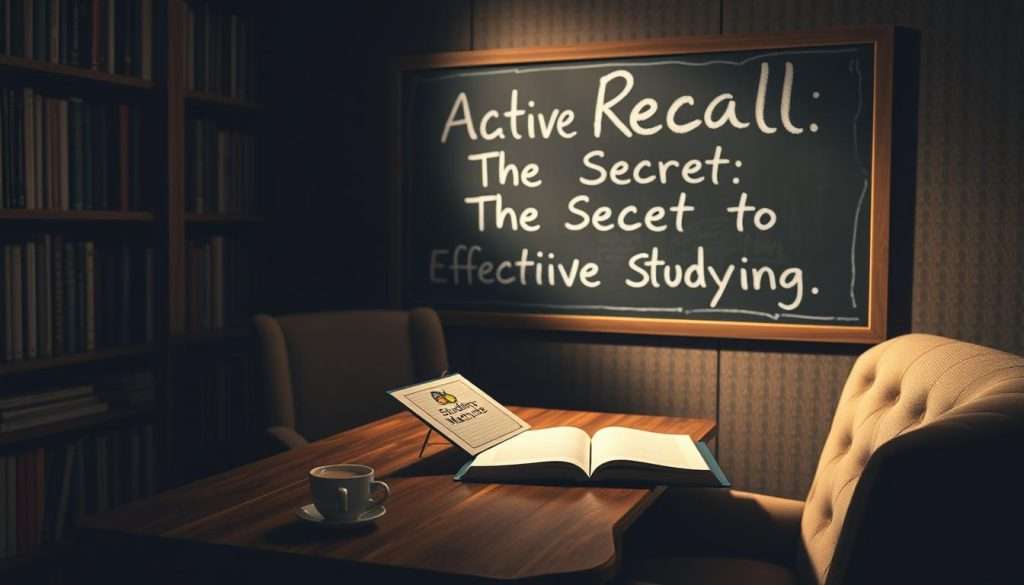Ever find yourself struggling to remember what you learned in class? You’re not alone. Endless rereading and highlighting just don’t work anymore. That’s where active recall comes in – a game-changing learning strategy for students.
So, what is active recall? It’s a method where you actively retrieve information from memory. This strengthens your understanding and keeps the material in your long-term memory. Unlike just reading your notes, you’re engaging with the information, making connections, and solidifying it in your long-term memory.
Key Takeaways
- Active recall is a powerful learning strategy that boosts retention and understanding.
- It involves actively retrieving information from memory, rather than just re-reading.
- This technique helps you engage with the material, making connections and solidifying it in your long-term memory.
- By using active recall, you can overcome the limitations of passive learning methods.
- It’s a simple yet effective way to take control of your learning and achieve your goals.
What is Active Recall?
So, what is active recall and how can it change your learning? Active recall means you actively try to remember information instead of just reading it again. This method is very good at keeping information in your mind and helping you understand it deeply.
Definition and Core Principles
Active recall is all about actively getting information from your memory. You can do this by testing yourself or writing it in your own words. The main idea is to use your brain when you learn, not just read or listen.
As
“The more you practice recalling information, the stronger the connection between the information and your ability to recall it becomes.”
This quote shows how important it is to repeat and practice with active recall.
Active vs. Passive Learning Methods
Active recall is different from just re-reading or highlighting. Passive learning can make you think you know something when you don’t. But active recall helps you see where you need to work harder, making it a better way to learn.
Adding active recall to your study routine can really improve your learning. It’s a simple but powerful way to keep information in your mind and reach your goals.
The Science Behind Active Recall
Let’s explore the world of cognitive psychology to learn about active recall. It’s not just a study trick. It’s based on how our brains handle and keep information.
Cognitive Psychology Research Findings
Studies in cognitive psychology reveal that active recall boosts memory. It makes our brains work hard to find information. This strengthens the connections between brain cells.
How Memory Formation and Retrieval Works
Memory creation and recall are intricate. When we learn something new, it forms new brain paths. Active recall makes these paths stronger, helping us remember better.
The Testing Effect
The testing effect shows that recalling info makes us better at remembering it. This is a key part of active recall.
Neural Pathway Strengthening
Recalling info does more than just bring it back. It also makes the brain paths stronger. This makes remembering it again easier.
| Process | Description | Outcome |
|---|---|---|
| Memory Formation | Creating new neural pathways | Initial Learning |
| Active Recall | Strengthening neural pathways | Improved Retention |
| Repeated Recall | Consolidating information | Long-term Memory |
Understanding active recall helps us use it to learn better. It’s a great tool for students and anyone who wants to keep learning.
Why Active Recall Trumps Traditional Study Methods
When studying, we often re-read and highlight our notes. But is this the best way to learn? Let’s explore active recall and compare it to traditional methods.
Effectiveness Compared to Re-reading and Highlighting
Re-reading and highlighting are passive learning methods. They don’t fully engage our brains. Active recall, on the other hand, strengthens our memory by actively recalling information.
Active recall goes beyond just memorizing. It helps us understand and apply what we’ve learned. By practicing recall, we improve our ability to use information in various situations.
Retention Rates and Long-term Learning
The true test of a study method is how well it helps us remember over time. Research shows active recall is better for long-term retention than traditional methods.
Research Studies and Statistics
Many studies support active recall’s effectiveness. For example, a study in “Psychological Science” found that recall practice led to higher retention rates than re-reading.
| Study Method | Retention Rate |
|---|---|
| Active Recall | 80% |
| Re-reading | 40% |
| Highlighting | 30% |
Adding active recall to your study routine can greatly improve your memory enhancement and learning experience.
The Relationship Between Active Recall and Spaced Repetition
Active recall and spaced repetition are two powerful learning methods. Together, they can greatly improve how much we learn. Let’s explore how they work together and how you can use them to your advantage.
How to Combine These Two Powerful Techniques
Using active recall with spaced repetition means reviewing material at longer intervals. First, you learn something, then review it briefly, and later at longer intervals. This active recall strengthens your memory.
Creating an Optimal Spacing Schedule
To make a good spacing schedule, think about the forgetting curve. This curve shows how memory fades without practice. By reviewing at the right times, you can keep information longer.
The Forgetting Curve and How to Beat It
The forgetting curve shows how quickly we forget things. Spaced repetition helps by reviewing material just before we forget. It’s not about constant recall, but reviewing at the best times to keep your memory sharp.
| Review Session | Interval | Recall Method |
|---|---|---|
| 1st Review | 1 day | Active Recall Quiz |
| 2nd Review | 1 week | Flashcards |
| 3rd Review | 1 month | Summary Recall |
By using spaced repetition and active recall, you can learn more efficiently. This education method helps you understand and apply what you learn, not just memorize it.
Step-by-Step Guide to Implementing Active Recall
To get the most out of active recall, follow this simple guide. Active recall is a powerful study technique that boosts learning and retention. We’ll show you how to use it effectively.
Preparing Your Study Material for Recall Practice
First, prepare your study materials. Organize your notes, textbooks, and resources. Use flashcards, create practice questions, or summarize your notes.
Start by gathering all your study materials. Organize them so you can easily review and practice recall. For example, make a flashcard deck with Anki or Quizlet, or list practice questions from your notes.
Creating Effective Recall Questions and Prompts
Creating the right recall questions is key. Your questions should be clear, concise, and challenging. Techniques like the Feynman Technique or summarizing in your own words work well.
Here are ways to make effective recall questions:
- Use key terms or concepts from your study materials.
- Create questions that require applying what you’ve learned.
- Mix up the type of questions to keep your practice sessions engaging.
Setting Up a Sustainable Practice Schedule
Consistency is crucial for active recall. A regular practice schedule helps make it a habit. Start with daily recall sessions and adjust as needed.
Daily, Weekly, and Monthly Review Cycles
To maximize active recall, include it in your daily routine. Spend 15 minutes each day on recall practice. Adjust your schedule to include weekly and monthly reviews for long-term retention.
By following these steps, you can effectively use active recall in your studies. Remember, consistency is key, and adjust your schedule as needed.
Active Recall Techniques for Different Subjects
Active recall is more than just a study method. It’s a flexible tool for various subjects and learning styles. This makes it a effective learning strategy for students in many fields.
Let’s see how active recall works for different subjects. In math and sciences, it’s about solving problems and using formulas. Here are some ways to do it:
Strategies for Mathematics and Sciences
- Create recall sheets with key formulas and concepts.
- Practice problem-solving without looking at solutions.
- Use flashcards to recall important terms and definitions.
In humanities and languages, it’s about remembering dates, events, and words. Some good methods include:
Approaches for Humanities and Languages
- Creating timelines to recall historical events.
- Using flashcards for vocabulary and key terms.
- Writing essays or short answers to recall questions.
For professional certifications and technical fields, remembering procedures and terms is key. Some strategies are:
Methods for Professional Certifications and Technical Fields
- Creating practice quizzes or tests.
- Using software or apps to simulate real-world scenarios.
- Recalling key concepts and procedures through teaching others.

By adjusting active recall to each subject’s needs, you can boost your learning effectiveness. This leads to better results in your studies or career.
Digital Tools and Apps That Enhance Active Recall
Using the right digital tools can boost your active recall and learning. Today, many apps and software help with memory and recall. They make studying easier and more effective.
Anki, Quizlet, and Other Flashcard Applications
Apps like Anki and Quizlet are great for active recall. They let you make digital flashcards to study anytime, anywhere. Anki uses a special algorithm to help you remember things at the right time.
Quizlet offers different study modes, like flashcards and games. It’s good for all kinds of subjects and learning styles. Using these apps can really help you remember things better.
Specialized Study Software and Platforms
There are also special study software and platforms. They add active recall to your learning. Some use AI to make study plans and exercises for you.
These tools help you remember things and see where you need to practice more. They make studying more efficient and effective.
Creating Your Own Digital Recall Systems
Creating your own digital recall system can be very personal. You can mix different tools like note apps, spreadsheets, and calendars. This way, you can make a system that fits you perfectly.
For example, use a note app for study materials, a spreadsheet for tracking, and a calendar for scheduling. This approach can improve your memory and make studying more productive.
Analog Methods for Practicing Active Recall
You don’t need fancy technology to practice active recall. Analog methods can be just as powerful. Using physical tools like paper and pen can sometimes make learning better. Let’s look at some effective analog techniques to boost your study sessions.
Mastering the Cornell Note-Taking System
The Cornell note-taking system is great for organizing your study materials. It divides your paper into sections for notes, summaries, and review questions. This way, you can actively engage with the material as you review it.
By summarizing information in your own words, you practice active recall. This is a key part of the system.
Creating Effective Paper Flashcards
Paper flashcards are a simple yet effective tool for practicing active recall. Write a question on one side and the answer on the other. This lets you test your knowledge as you review the cards.
This method is especially useful for memorizing key terms and concepts.
Implementing the Feynman Technique for Deep Understanding
The Feynman Technique involves teaching a concept to someone else as if you’re explaining it for the first time. This method promotes deep understanding. It helps you identify areas where you need more practice.
By simplifying complex information, you reinforce your own learning. This improves your ability to recall the information later.
By adding these analog methods to your study routine, you can create a strong practice. This complements digital tools and enhances your overall learning experience.
Common Mistakes to Avoid When Using Active Recall
Active recall can change the game, but only if you steer clear of common errors. As you begin using this powerful method, watch out for mistakes that can hinder its benefits.
Confusing Recognition with True Recall
One big mistake in active recall is mixing up recognition with true recall. Just because you think you know something doesn’t mean you can recall it when it counts.
To sidestep this, ensure you’re testing yourself in a way that demands active recall, not just passive recognition. Try recalling information without looking at your notes or other resources.
Scheduling Errors: Too Much or Too Little Spacing
Another common blunder is messing up the spacing. Spaced repetition is key to active recall, but it’s easy to mess up. If you space out too much, you might forget before recalling. On the flip side, practicing too often can mean not enough forgetting time.
| Spacing Schedule | Effectiveness |
|---|---|
| Too little spacing | Low retention rates |
| Optimal spacing | High retention rates |
| Too much spacing | Low retention rates |
Creating Ineffective or Overly Complex Practice Questions
The quality of your practice questions is key to active recall success. Steer clear of questions that are too simple or too complex, and ensure they’re relevant to what you’re learning.
“The art of teaching is not just about conveying information, but about creating a context in which students can learn.” –
To craft effective practice questions, focus on the most important info. Aim for questions that are concise and clear.

By avoiding these common pitfalls, you can maximize the benefits of active recall and reach your learning goals.
Overcoming Challenges in Your Active Recall Practice
Starting an active recall journey can be tough. You might face initial hurdles or feel frustrated. But remember, these are normal parts of learning.
Dealing with Initial Difficulty and Frustration
Feeling challenged at first is common. The important thing is to keep going. Even if you can’t get it right away, trying helps you remember better over time. This method boosts your ability to recall, making it a great study technique.
Building Consistency and Long-term Study Habits
Staying consistent is key to good study habits. Create a schedule that fits you and stick to it. Regular practice makes learning stick, making it easier to recall later.
Adapting Techniques for Learning Disabilities and Different Learning Styles
Active recall can be tailored for different needs. Whether you have a learning disability or a unique style, you can adjust the method. Using visual or auditory aids can help your learning.
Real-World Success Stories with Active Recall
Active recall has changed how we learn, leading to amazing success stories. It’s a key to better effective learning and memory enhancement.
Academic Achievements
Students have seen big improvements in their grades by using active recall. A study found that undergrads who used active recall got better grades than those who didn’t.
| Study Method | Average Grade |
|---|---|
| Active Recall | A- |
| Traditional Methods | B+ |
Professional Learning Applications
Professionals also benefit from active recall. For example, doctors use it to remember complex medical info better. This leads to better care for patients.
Personal Development and Lifelong Learning
Active recall helps people learn new things easily and well. It makes learning new info more efficient. This encourages a love for learning and personal growth.
These stories show how active recall works in many areas. It’s a great tool for anyone wanting to learn better.
Conclusion: Making Active Recall Your Study Superpower
Active recall is a game-changer for learners of all ages. It helps you remember what you’ve learned before. This not only strengthens your understanding but also builds a more reliable memory.
Consistent recall practice unlocks active recall’s full potential. Cognitive psychology research shows it strengthens memory. By adding recall practice to your study routine, you’ll retain information better and recall it when needed.
Make active recall your study superpower! It’s a big step towards reaching your academic or professional goals. With regular practice, you’ll learn and retain more. Start using active recall daily and see your learning abilities grow.

